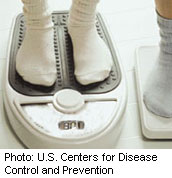
TUESDAY, Jan. 17 (HealthDay News) — One in three American adults and one in six American children are obese, new government reports show.
That’s the bad news. The good news is that over the past 12 years, those rates have remained roughly the same.
“The stabilization of obesity rates has been going on for some time. And, this is not just the U.S. It’s happening all over the world,” said Katherine Flegal, author of the reports and a senior research scientist with the National Center for Health Statistics at the U.S. Centers for Disease Control and Prevention.
“Even if we can just keep the prevalence rates the same, we’re doing well,” said registered dietitian Nancy Copperman, director of public health initiatives in the Office of Community Health at the North Shore-LIJ Health System in Great Neck, N.Y.
“It’s as if you’re on an expressway going 65 miles per hour. You can’t suddenly throw the car in reverse. You have to slow down before you can reverse course. Hopefully, what we’re doing now is slowing down so we can reverse course,” Copperman said.
The reports on the obesity trends — one on adults and one on children and teens — are published in the Jan. 17 issue of the Journal of the American Medical Association. Flegal is the lead author of the study on obesity in adults, and the senior author on the study on obesity in children and adolescents.
The consequences of obesity are far-reaching. People who are obese are more likely to develop type 2 diabetes, heart disease, stroke, high blood pressure, certain cancers, high cholesterol, liver and gallbladder disease, sleep apnea, osteoarthritis and gynecological problems, according to the CDC.
The estimated medical costs of caring for the obese average about $147 billion a year, the CDC estimates.
In the current study of obesity trends in adults, Flegal and her colleagues reviewed data from the most recent U.S. National Health and Nutrition Examination Survey (NHANES), from 2009 to 2010. They compared this data to older adult obesity data from 1999 through 2008. The newer set of data included nearly 6,000 adult men and women. The older set of data included almost 23,000 American men and women.
According to the latest data, the average body mass index (BMI) was 28.7 for men and women. BMI is a rough estimate of a person’s body fat. The higher the number, the more overweight or obese a person is. A BMI of 25 to 29.9 is overweight in an adult, and 30 or above is considered obese for an adult, according to the CDC. This means the average American is overweight, but not obese.
However, the rate of obesity was nearly 36 percent for both adult men and adult women in 2009 to 2010. In general, this rate has remained stable since 1999, according to the study.
Several groups did see small, but statistically significant increases in the rate of obesity over the 12-year study period. They included non-Hispanic black women, and Mexican-American women and men, according to the study.
The second study compared the most recent obesity figures (2009-2010) in children and teens from NHANES to obesity trends from six other surveys dating back to 1999 to 2000. The most recent data included 4,111 American children.
In 2009 to 2010, nearly 17 percent of children and adolescents were obese and almost 32 percent were overweight or obese, according to the study. Obesity rates from 2007 to 2008 and 2009 to 2010 stayed the same. The researchers did find an increase in the prevalence of obesity in male children and teens when they compared the most recent figures to 1999 to 2000.
In infants, overweight is measured through weight-for-recumbent length. Almost 10 percent of infants had a high weight-for-recumbent length measurement. But, this rate was the same in 2009 to 2010 as it was in 1999 to 2000, except for one group. Mexican-Americans infants were more likely to have a high weight-for-recumbent length than infants born to other groups.
“We need to think about the populations that are shown in these studies to have a higher prevalence of obesity, and what interventions we can do,” Copperman said. “We need to figure out what is different about them, and we may need to tailor prevention specifically to those populations.”
Copperman also said it’s important to focus on prevention to avoid obesity in the first place. “When you look at this from a public health perspective, it’s easier to prevent something than to let it run its course and then try to treat it. Being overweight and obese isn’t just a cosmetic thing, it’s a disease,” she added.
More information
Learn more about living at a healthy weight from the U.S. Centers for Disease Control and Prevention.

